If you enjoy ripping around the track on your go-kart, whether that be on pavement or on a dirt track, the last thing you want is to have your go-kart take off when it’s been started or when idling at a stop.
Like full-size vehicles, go-karts require specific maintenance and tuning which, if neglected, can lead to your go-kart seemingly having a mind of its own. In reality, the truth is much less dramatic and your go-kart may simply be in need of some basic maintenance or replacement parts.
Go-karts utilize either a centrifugal clutch or torque-converter and depending on your setup, the proper solution will vary. This article will cover the top 5 reasons why your go-kart takes off when started or moves while idling and will provide you the best way to solve the problem based on your individual setup.
Here are the top 5 reasons why your go kart moves while idling:
- Go-Kart Has No Transmission
- Engine Idle is Set Too High
- Worn or Faulty Clutch (Centrifugal Clutch)
- Incorrect Belt Size (Torque Converter)
- Sticking Transmission (Torque Converter)
1. Go-Kart Has No Transmission
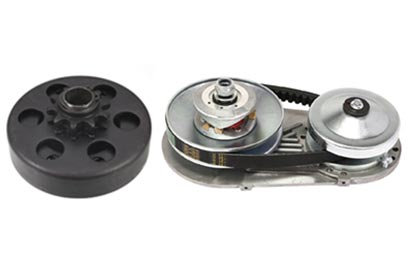
Quick Summary:
- Install a centrifugal clutch or a torque converter on your go-kart
The most simple of karts do not utilize a clutch and do not utilize a torque converter to get power to the wheels. Instead, they utilize a direct drive transmission. A direct drive go-kart is when the crankshaft of the engine is connected directly to the rear axle via two sprockets and a drive chain.
This setup is simple, durable, and easy to repair on the fly. However, it does not allow the kart to idle without moving. If the engine is on and turning, the kart will move without any input from the driver. However, certain go-kart engines have an idle feature that you can set.
How To Fix It:
In order to fix this issue, you’ll have to install one of two components: a centrifugal clutch or a torque converter. A centrifugal clutch is a simple mechanical device that uses centrifugal force to engage a series of shoes and friction pads that extend within a drum to lock the drum to engine speed and provide forward motion.
Torque converters utilize a set of pulleys and belts that work with each other to provide a wide-spread of ratios across various engine speeds. Both of these transmissions are great options for a go-kart and a properly installed transmission should not move while idling.
If the lack of a go-kart transmission is the cause for your kart to move when idle, you should think of installing one that is suitable. Both of these transmissions are easy to install, so feel free to read up more on the go-kart clutch vs torque converter topic.
2. Engine Idle is Set Too High
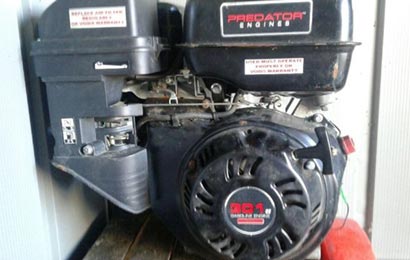
Quick Summary:
- Locate the idle speed screw on your engine
- Lower it to below the engagement range of your transmission
Your Go-Kart is designed to idle at a speed that allows the transmission (no matter which set up) to smoothly engage. Centrifugal clutches, for example, are designed to engage at a particular engine speed – most commonly about 1,400 to 1,600 rpm.
If your idle speed is set too high, your transmission will engage and then move your go-kart forward without throttle input. Depending on your go-kart specification and application, the proper idle speed can vary greatly.
This is also true for torque converters, that start to engage when the engine hits a certain rpm range – typically at about 1,500. This means if the engine idle speed is set too high, your torque converter will start engaging the moment the engine is started.
How To Fix It:
Most gas engine go-karts, whether 2 or 4-stroke, have a component called an idle screw which is used to control the idle speed of the go-kart. You’ll need to consult with the manufacturers of both your engine and your transmission to determine what the best idle speed for your particular application is.
Generally speaking your engine idle speed should be set below the transmission engagement ranges which are as below:
- Centrifugal Clutch: Engages at about 1,400 to 1,600 rpm (Set engine idle speed lower)
- Torque Converter: Engages at about 1,500 rpm (Set engine idle speed lower)
You’ll have to check exactly what the best idle setting is for your go-kart. It’s best to use manufacturer guidelines. Adjust the speed too low and a clutch-equipped kart may struggle to engage and the clutch will prematurely wear out. If set too high, the kart will engage the clutch and move on its own. Overall, a very simple fix through trial and error.
3. Worn or Faulty Clutch (Centrifugal Clutch)
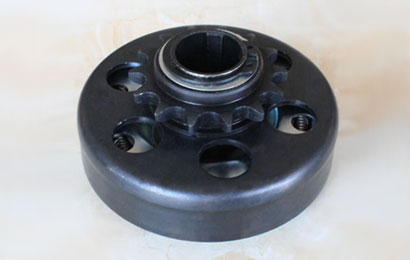
Quick Summary:
- Oil the bushing underneath the snap ring
- Replace internal parts if damaged
If your centrifugal clutch is malfunctioning or worn out, it may lead to your go-kart moving at idle. One of the most common reasons for failure is heat damage within the clutch drum, which causes the clutch to remain engaged no matter the engine speed. This in turn means that your go-kart moves the moment the engine is started.
This happens for a variety of reasons such as improperly lubricated bushing or from driving your kart too slow. Yes, driving your kart too slow can lead to partial engagement of the clutch (slipping) and lead to premature failure or lock up!
How To Fix It:
If your clutch is worn, you can try applying oil to the bushing as the first matter of repair. In fact, you should be doing this regularly after approximately 2 hours of driving time to avoid premature clutch damage due to wear and tear. You can check out the guide on how to oil a go-kart clutch for more information.
Once heat damage occurs from either maintenance neglect or improper operation, you’ll need to replace the entire unit. For most go-kart enthusiasts, this is a repair that can be accomplished in a few minutes. Lastly, make sure you drive your kart at the proper speed to minimize clutch wear.
4. Incorrect Belt Size (Torque Converter)
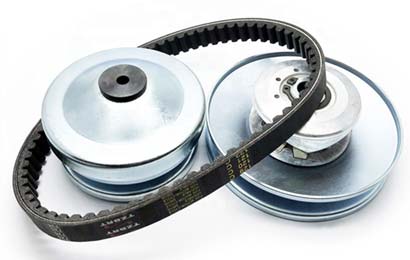
Quick Summary:
- Measure the belt on your torque converter
- Replace belt if worn or too small
On go-karts equipped with a torque converter you will need to regularly maintain or replace the belt between the driven pulley and the driving pulley. This belt is designed to have some slack present at idle speed and gradually tighten as the engine speeds increase.
If a wrong sized belt is used, this lack of slack will cause the kart to creep forward even without throttle input. On the other hand, if the belt is too loose, you may not get any throttle response at all.
How To Fix It:
In order to properly size your belt, you’ll need a few pieces of information. First, you’ll need to grab the diameter of the driven pulley which is the pulley not directly attached to your crankshaft. Next, you’ll measure the center distance, which is the distance from the center of one pulley to the center of the other. I’ve created a separate guide on how to measure a go-kart belt.
This information will allow you to check this against a go-kart belt size chart, so that you know which torque converter belt you need for your setup. You should always try to stick with the manufacturers recommendations and do your own testing afterwards. Just ensure that there is enough slack in the belt after maintaining or replacing it.
5. Sticking Transmission (Torque Converter)
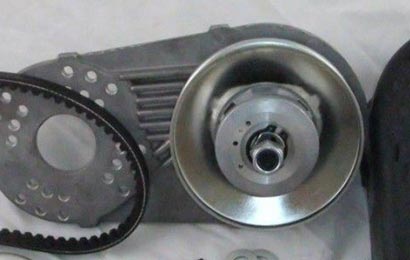
Quick Summary:
- Either lubricate parts, replace springs or realign dislodged weights
Over time and through improper maintenance, some torque converters can ‘stick’. When a torque converter sticks, it doesn’t successfully disengage, which causes your go-kart to take off when it’s supposed to idle.
This can happen when the weights inside the driving pulley get stuck in the grooves of the torque converter drum, the springs are too soft or the weights get dislodged. This problem can even occur if you’re properly maintaining your torque converter, so it’s always good to check this from time to time. The problem is further explained in this video.
How To Fix It:
There are several ways to fix a sticking torque converter. The way to fix this depends on what is causing it to stick in the first place. Here is quick summary on the fixes:
- Weights get stuck in grooves (Fix: Lubricate parts properly)
- Springs are too soft (Fix: Replace with heavier springs)
- Weights get dislodged (Fix: Realign weights)
If the weights inside the torque converter are stuck in the grooves, they can’t return to the original idle position and will cause it to be constantly engaged. To fix this, try to lubricate the parts regularly.
Another reason could be that the springs are too soft and don’t ‘pull’ the weights back into the original position. You can fix this by replacing the original springs with slightly heavier ones. Just take note that springs that are too heavy could increase your idle speed drastically.
Lastly, your torque converter weights could also be dislodged. This can happen from time to time and all you’ll need to do is temporarily remove them and realign them properly.
Conclusion
I hope this guide was able to help you fix your go-kart idling issues. The most common reason for go-karts taking off immediately after the engine is started is due to the transmission being engaged when it shouldn’t be. The best way to go about fixing it is to pinpoint the source of the problem and fix it. It’s also good practice to inspect your go-kart parts regularly during maintenance.
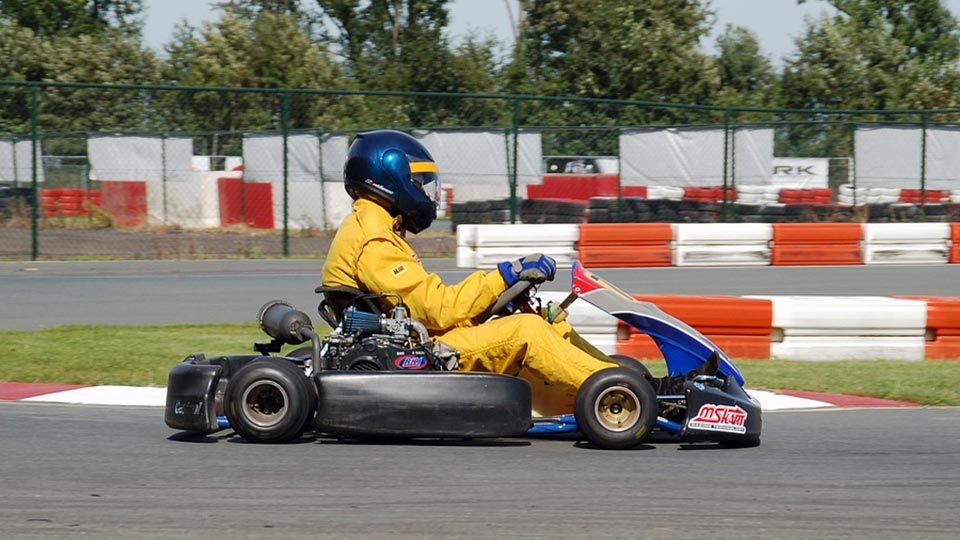

The clutch does not want to disingage and it’s a tecumsen 6.0 (2000)so do i need to take clutch out or just lube it
Hi Jeffrey,
That depends on what’s wrong with your go-kart clutch.
Check out this guide on fixing go-kart clutch.
New go kart worked good for first couple times now after idling more than a few seconds the clutch lets out a screech and kills the engine .im thinking lube first idle adjust idle second . Ambient air was right at freezing would that up my idle?
Hey Theodore, that’s strange.
I’d open up the clutch first to check springs and friction material.
Then lubricating and oiling the clutch it would be a good idea to check if it still persists.
Is there any instance in which the entire torque converter might need to be replaced?
I’ve gone through this whole list of fixes and nothing seems to be an obvious issue. I replaced the belt (and a worn through bronze brushing) first and that just made things worse. I tried lowering the engine idle and that didn’t work. I tried adjusting the throttle cable in case it was too tight, but it still tried to run off even with it entirely disconnected. I completely dismantled the torque converter and cleaned everything up and while I DID find some issue, none of them were apparently the culprit.
I’m at my wit’s end here. It just won’t stop trying to take off from idle, and the only thought that I have left is possibly replacing the entire torque converter, which I don’t want to do unless I have to.
Gocart takes off when I pull cord, put on blocks pulled cord, starts up and wheels turn, set idle, still same, can’t ride because can’t get in cart. Had it pushed and takes off but if you stop one has to do it all over?